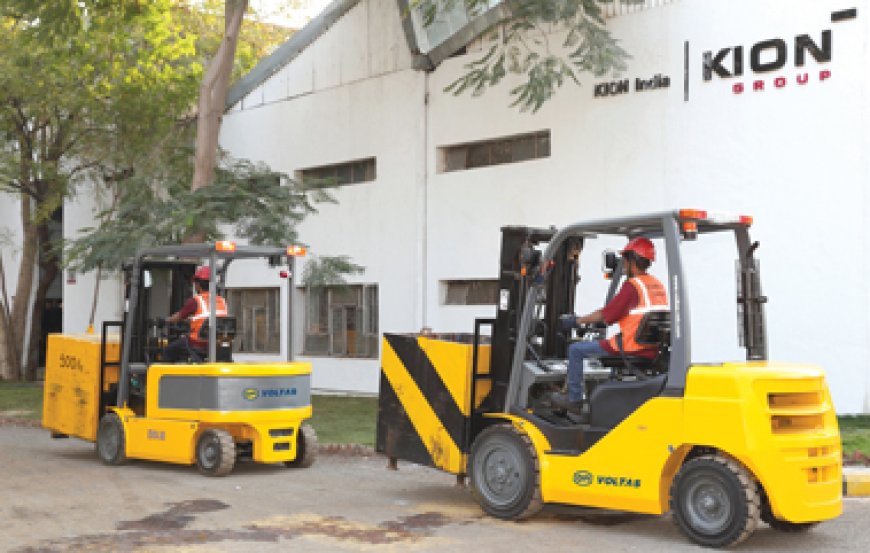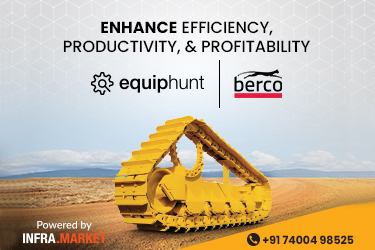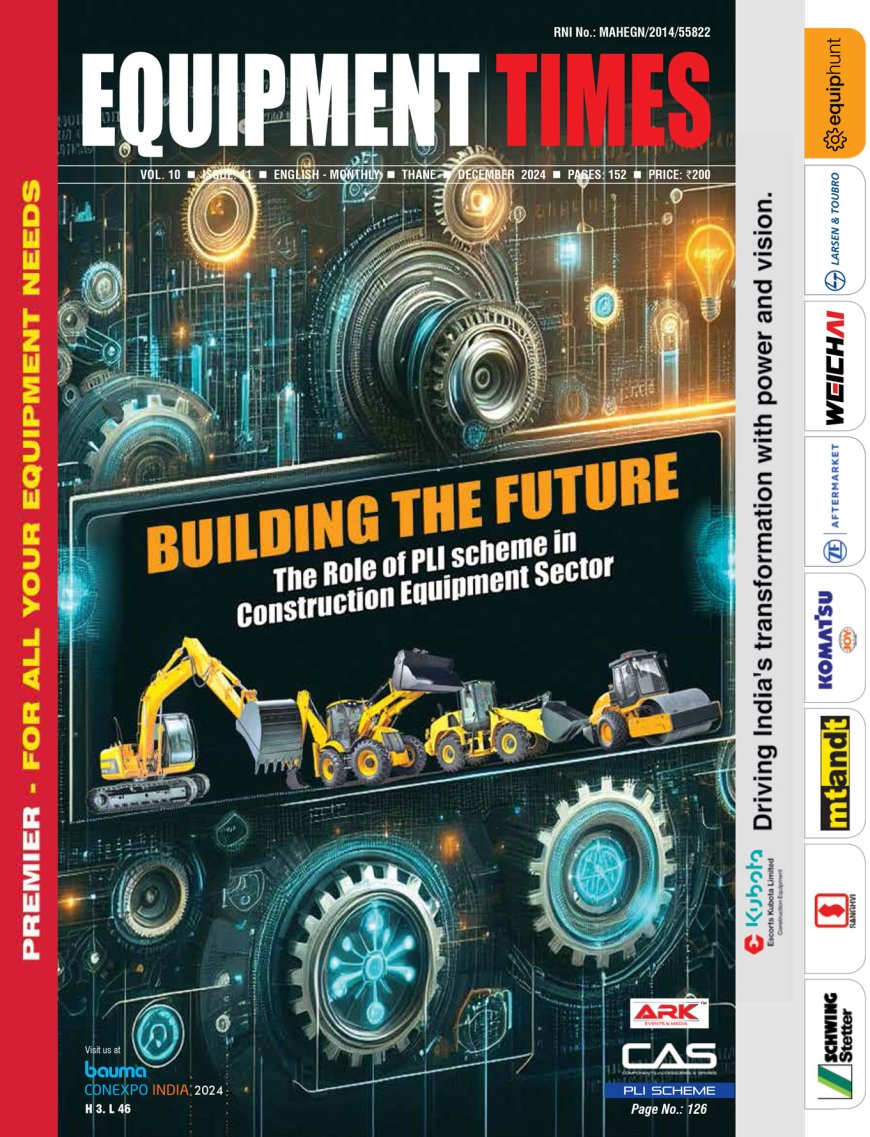Getting Smarter and Safer
With GST unifying the market, the MHE segment has seen a rise in logistics and warehousing activities as companies would like to have consolidated warehouses which are larger/higher and automated. On the other hand, the latest development and policy upgradation

With GST unifying the market, the MHE segment has seen a rise in logistics and warehousing activities as companies would like to have consolidated warehouses which are larger/higher and automated. On the other hand, the latest development and policy upgradation in the port sector has also brought in investment friendly environment for port industry that is expected to trigger the demand for warehouse equipment.
 With the changing business dynamics, growth of 3PL and big bang of e-commerce industry, the growth story for the warehouses has just begun. The roll out of GST has initiated consolidation of hitherto numerous, smaller warehouses into fewer but large capacity locations, which will then find mechanized handling of material a profitable option. There is perceptible shift towards smart warehouses which clearly depicts the importance of highly productive and efficient warehouse in complete supply value chain.
With the changing business dynamics, growth of 3PL and big bang of e-commerce industry, the growth story for the warehouses has just begun. The roll out of GST has initiated consolidation of hitherto numerous, smaller warehouses into fewer but large capacity locations, which will then find mechanized handling of material a profitable option. There is perceptible shift towards smart warehouses which clearly depicts the importance of highly productive and efficient warehouse in complete supply value chain.
On the other hand, stepping up its reform pace, the government of India has issued a new set of bidding guidelines for public-private-partnership (PPP) contracts for port development modelled on the bidding approach used for PPP projects in the highway sector. Increasing investments and cargo traffic point towards a healthy outlook for the Indian ports sector. And according to Nitin Gadkari, Minister Road Transport, Highways and Shipping Indian ports are expected to generate a profit of Rs 7,000 crore this year. This augurs well for the MHE segment.
“Port is a high value customer for industrial trucks business. The latest development and policy upgradation are creating investment friendly environment for port industry and we will see much more investments in the port segment in coming years. Spending on modern infrastructure with a focus on increased efficiency leads to increased demand for industrial trucks and warehousing equipment. Our specific equipment (forklift) designed to cater the requirement of port segment will definitely get a boost due to increasing demand of port segment,” states Sunil K Gupta CEO & MD – Kion India.
GST Impact
Equipment Times tried to find out the impact of GST on the warehousing / logistics sector as it had been perceived that GST implementation will help the industry to shift from ‘Tax Efficiency’ to ‘Operational Efficiency’ resulting into technology and demand increase for material handling equipment. Gupta elaborates. “Indian logistics sector broadly comprises the road transport sector (consisting of unorganized small businesses, trucking, fleets and large transport companies), the storage and warehousing sector and finally third-party logistics (3PL). Complicated networks, higher coordination costs across the supply chain coupled with deficient infrastructure, different entry taxes and poor vehicle-load-carrying capacities were now way behind. The roll out of GST addressed many of these problems resulting focus on ‘Operational Efficiency’ rather than “Tax Efficiency’. This is a catalyst for technology based material handling solution provider like us. The material handling equipment market already witnessed a very high growth in H2 2017; which is likely to be continued in 2018.
Gupta further adds, “GST has removed the cascading impact of multiple taxes; which is very positive for hiring segment as overall cost of machine to them reduced hence better ROI. A continued double digit growth is expected in the demand of hiring segment in 2018.”
“GST was something which we had been looking forward to for the past few years. Prior to the launch of GST, the location of customer sites and storage of goods were dependent on states, tax sops, suppliers’ base, etc. With GST unifying the market, we have seen a rise in logistics and warehousing activities as companies would like to consolidated warehouses which are larger/higher and automated. This will lead to growth in number of material handling equipment required, which will improve the prospects of handling equipment industry as well. So we expect a faster change in terms of technology upgradation and automation leading to increase in operational efficiency,” states Manojit Acharya, Managing Director, Jugheninrich Lift Trucks India.
Market Potential
Acharya sketches the global scenario in comparison with the Indian market. According to Acharya the requirement for trucks is 930 and 235 units per million people per year in Germany and China, respectively. In India, the number of truck per million people per year is less than 10. The statistics is a clear indication of the huge potential. “So, compared to global markets, the Indian market is very small. However, the trend of using safe and reliable products that are highly efficient, coupled with the need of companies to build larger and higher warehouse, we see a tremendous potential for growth in this market,” points out Acharya. He adds, “On an average, the market is expected to have a sustainable growth of 8-10 per cent year-on-year.”
Market Size & Segments
As per the industry inputs the size of the MHE industry is approximately 9000-10000 units per annum and it expects a double digit growth in coming years with higher than average growth in E and WHE segments. Light forklifts with capacity of 1.5 to 3T constitutes the major chunk of the market with 85% of the MHE market while medium forklifts with capacity of 4 to 8T make up around 10%, and heavy duty (8T and above) accounts for less than 5% of
the market.
Lift trucks are used across a host of different industries. Some of these industry verticals are manufacturing, pharmaceuticals, warehousing and logistics, food and beverage and FMCG. Each vertical has its own unique requirements. For example, in case of a general manufacturing industry, the requirements will typically be for a lift truck having a capacity of 3T and above driven either electrically or by an IC engine. Warehousing and logistics customers typically require stackers and pallet trucks handling loads in the range of 1T – 1.5T but having extremely high speeds and high levels of productivity. In case of Pharma and Food industry, the requirements are pretty stringent from point of view of ‘cleanliness’ of operations. These industries will typically also require lift trucks that are suitable for operation in cold stores where temperatures could be as low
as -200C.
As the market is maturing and the requirements are evolving the industry is witnessing emergence of some distinct trends. “Electric counterbalanced lift trucks are being preferred more over IC engine driven lift trucks. With the emergence of logistics and warehousing industry riding on the tailwinds of growth in e-commerce, a trend of using high end, high productivity and high reliability equipment is emerging,” says Tushar Mehendale, Managing Director, ElectroMech. He adds, “In our estimate, while the overall demand will keep on increasing steadily, there will be a definite shift in the share of the market with a clear shifting of preference of end users towards equipment employing the latest technologies, offering high rates of productivity and enhancing safety in the operations.”
Automated Warehouses
The industry sees a bright future for the emergence of highly automated warehouses. “GST has provided a shot in arm for automation. We expect a consolidation in warehouses, and there would be larger warehouse with need for higher efficiencies. Gradually customers will shift towards automated warehouses,” says Acharya.
Gupta is also on the same page. According to him with the increase in industrial growth, rise in demand of consumer goods and services augmented by increase in disposable income and focus on efficiency and safety, market is shifting towards automated products and solutions in coming years.
“Practically after a certain volume; manual material handling is beyond human control and requires advance and automated solutions. As much we move towards large capacity warehouses, automated and smart warehouses become vital for efficient operations. With the environment awareness as well as compliances and govt. push towards green and clean energy, future smart warehouses are likely to be based on non-pollutant energy efficient material handling equipment. Battery operated electric forklifts and warehousing equipment will be base of automated/smart warehouses and pull the demand of battery operated material handling equipment,” explains Gupta.
Technology deployment and its subsequent adoption depend very much as to where a particular market is on the life cycle curve. In countries like India, the demand is slowly but surely changing from basic de-featured lift trucks to a lift truck that has on board diagnostics, driver assist features as well as telemetry. Currently, due to the low scale of operations (as compared to developed countries) in majority of the plants, there aren’t enough incentives to spend a lot of money on equipment. This is the foremost hurdle in implementing sophisticated on-board technologies on lift trucks. However, all trends in India are pointing towards increasing sophistication in the requirements of the customers and pretty soon we will be seeing a definite shift towards ‘high technology’ lift trucks, elaborates Mehendale.
The MHE market is witnessing a demand for cost effective products with enhanced features, leading to growth in the value for money segment.
There is a need for more efficient and reliable products. Cashing in on the demand OEMs have left no stones unturned that they are able to offer products which are more user friendly and safer; and offers techniques like height pre-selection, operator sensors, overload protection, travel speed control and lift speed control. R&D teams of major players continuously connected with global R&D centers are working along with them on world class technological solutions to suit the evolving market needs.
Hits: 66










